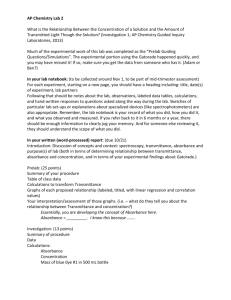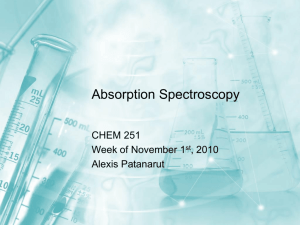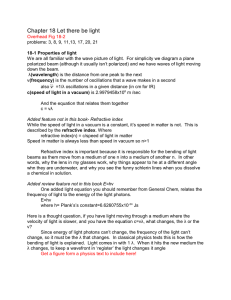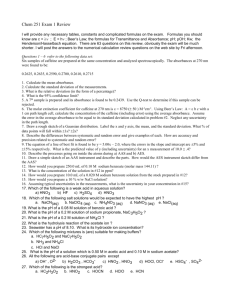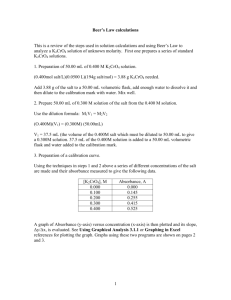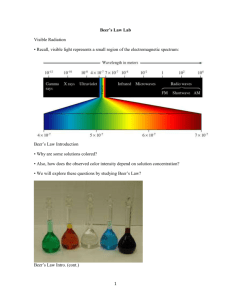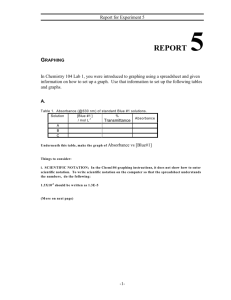Beers_Law - Klemmer
advertisement
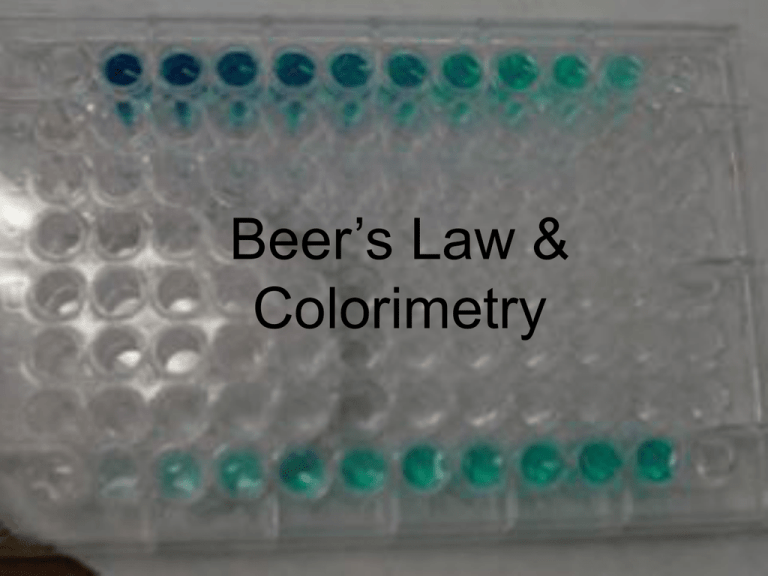
Beer’s Law & Colorimetry Absorbance ABSORBANCE is the amount of light that gets “stopped” by a material • “Zero” = a perfectly transparent material that lets all light through. • “Infinity” = a completely opaque material that does not let any light through. Absorbance (A) is directly proportional to concentration (c) : A = kc. This is a mathematical model for something you already know: a darker solution is a more concentrated one. Path Length PATH LENGTH is the distance light travels through a solution. PATH LENGTH (b) is directly proportional to absorbance (A) : A = kb. less dark “neck” darker “belly” Note how the solution in the “belly” of this volumetric flask is darker than the solution in the neck. Beer’s Law A = abc absorbance constant (nature of solute) path length concentration Beer’s Law puts all the factors that affect absorbance together in one equation. Beer’s Law Graphs absorbance If we are using only one solute, then “a” is a constant. If we are are careful to always use the same path length, then “b” is a constant, too. This simplifies Beer’s Law to: A = kc. concentration If we can measure the absorbance of several known concentrations of a solution, we can make a straight line graph. absorbance Using Graphs concentration Then, we can find the concentration of any “unknown” by measuring it’s absorbance and interpolating the concentration. Colorimeters Transmittance Colorimeters actually measure TRANSMITTANCE: the amount of light that goes through a solution. • “100%” = a perfectly transparent material that lets all light through. • “0%” = a completely opaque material that does not let any light through absorbance %Transmittance A Comparison concentration concentration At c =0, A = 0. At c =0, %T =100. At c = ∞, A = ∞. A and c are directly proportional. At c = ∞, A = 0. A and c are exponentially related. A %T Absorbance and transmittance are related exponentially. 10-A = %T/100 so if A = 1: 10-1 = 0.1 = T, or %T = 10% if A = 2, 10-2 = 0.01 = T or %T = 1% We will usually deal with A < 1. if A = 0.5, 10-0.5 = 0.316 = T or %T = 31.6% if A = 0.1, 10-0.1 = 0.794 = T or %T = 79.4% Make sure you can duplicate these calculations on YOUR calculator! %T A Most of the time, we need to convert %T (from the colorimeter) to A (so we can plot the direct relationship between A and c. A = -log(%T/100) so if %T = 90%, A = -log (90/100) = -log(.90) = 0.045 if %T = 45%, A = -log (45/100) = 0.347 Make sure you can duplicate these calculations on YOUR calculator! Sample Problem 1. Calculate “A” for the transmittances in this data table. 2. Graph “c” vs. “A” and get a best fit straight line. 3. If an unknown K2CrO4 (aq) solution was measured at 53.7%T, what would be it’s concentration? K2CrO4 (aq) Concentration (M) %Transmittance 0.000 0.125 100 79.4 0.250 0.375 63.1 50.1 Answer At 53.7% T, A = -log(0.537) = 0.270 From the graph, @ 0.270 for “A”, c = 0.338M
